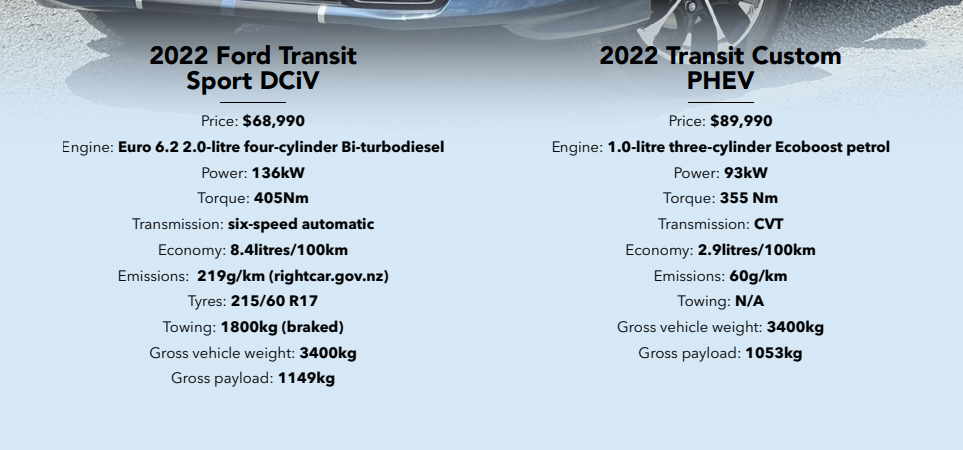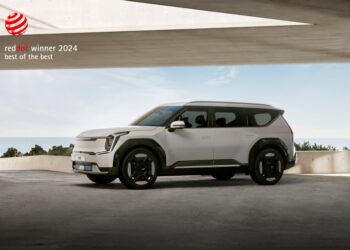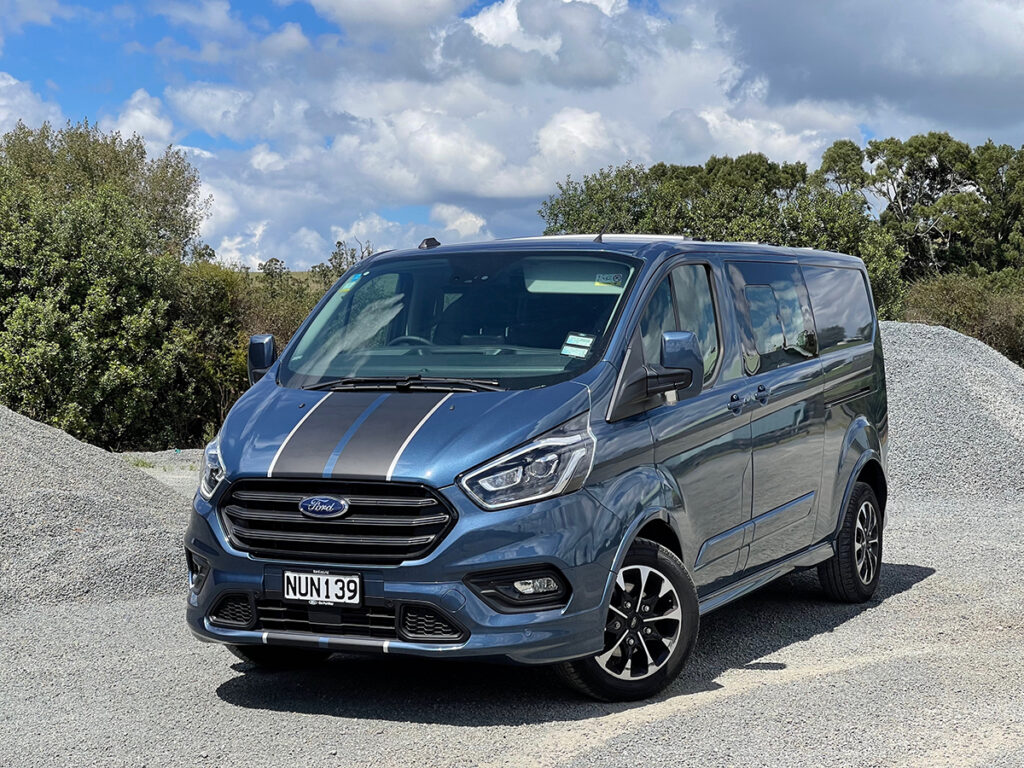
Ford’s mid-size Transit Custom van has been produced since 2012 and received a significant facelift a couple of years ago.
Most recently, Ford introduced two additional variants to broaden the model’s appeal in two quite different markets.
We’ve driven the versatile long wheelbase (LWB) Transit Custom Sport Double Cab in Van (DCIV) and the commercially focused short wheelbase (SWB) Transit Custom plug-in hybrid electric vehicle (PHEV).
These two recent range additions transit in quite different directions but show the breadth of the Blue Oval’s light commercial portfolio.
The Sport DCIV targets buyers looking for a well-equipped, comfortable, good-looking workhorse that can do double duty as family vehicle after hours and on weekends.
The PHEV is an urban-focused lowemission last mile delivery warrior. Both are suited perfectly for their assigned roles.
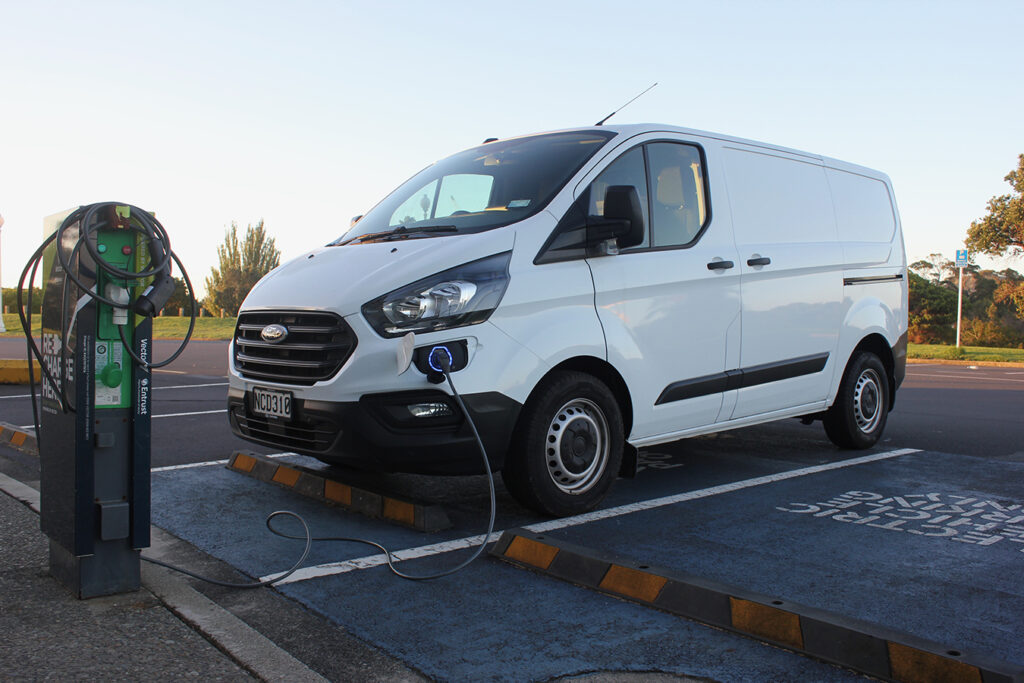
THE RANGE
In addition to the Sport DCIV and the PHEV, buyers can choose from a Sport SWB which seats three people in the cabin, or the more workaday SWB and LWB Transit Custom panel vans with cloth seats and steel wheels.
The Custom SWB and LWB panel vans have a 125kW/390Nm version of the 2.0-litre Eco Blue turbodiesel engine.
The SWB and LWB Sport models run a 136kW/450Nm bi-turbodiesel engine. All come with a six-speed automatic transmission.
The SWB Transit Custom PHEV has a completely different powertrain. Its 1.0-litre three-cylinder petrol engine is used as a generator to provide energy to the batteries to power the electric motor once the 56km of electric range from mains electricity has been depleted from the 13.6kWh lithium-ion traction battery pack.
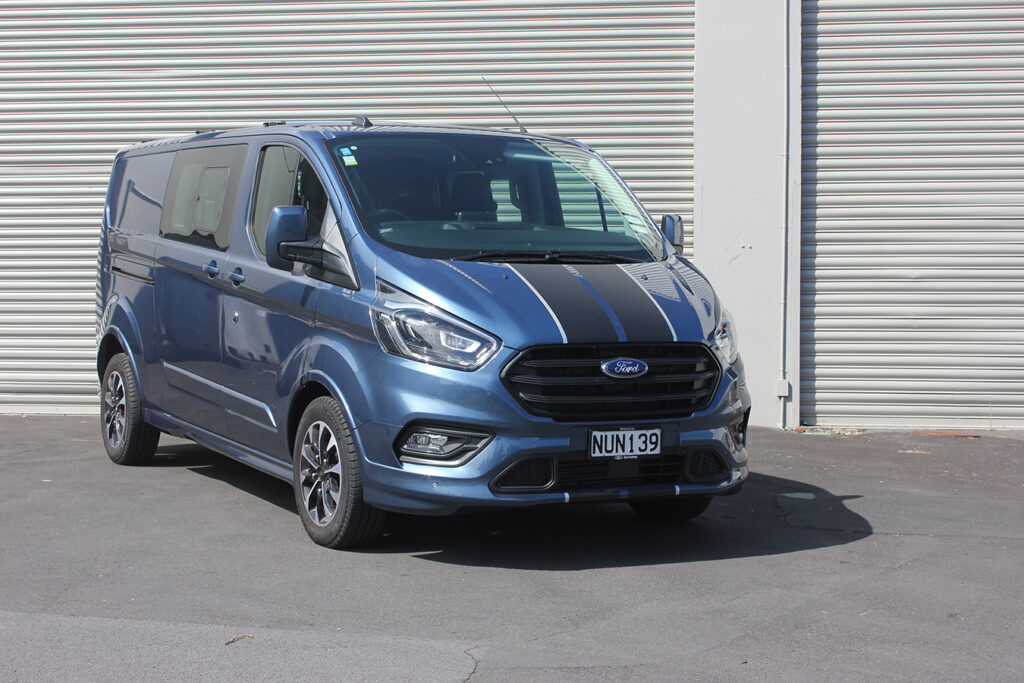
THE LOOK
In 2019, the Transit Custom range received a significant exterior update and the interior and dashboard received significant changes.
Both the Transit Custom and its sibling the Tourneo people mover received a more aggressive-looking front fascia with newly designed headlights and foglights, and a bolder five-bar chrome trapezoidal grille.
Making a statement with racinginspired stripes and unique decals, the DCiV Sport comes in two exclusive colours, Blue Metallic as pictured on the cover page and Orange Glow.
It’s further distinguished from workhorse focused Transit Customs by 17-inch black machined alloy wheels and a body styling kit with unique front and rear bumpers and side skirts.
Body coloured mirrors and a gloss black grille are joined by Bi-Xenon HID headlights that also feature static bending and LED Daytime Running Lights.
The PHEV like its workaday ICE siblings, rolls on 16-inch steel wheels, and has black plastic front and rear bumpers, side mouldings and mirror housings. It’s distinguished externally from the diesels by the Type 2 charging point inset into the left-hand side of the front bumper.
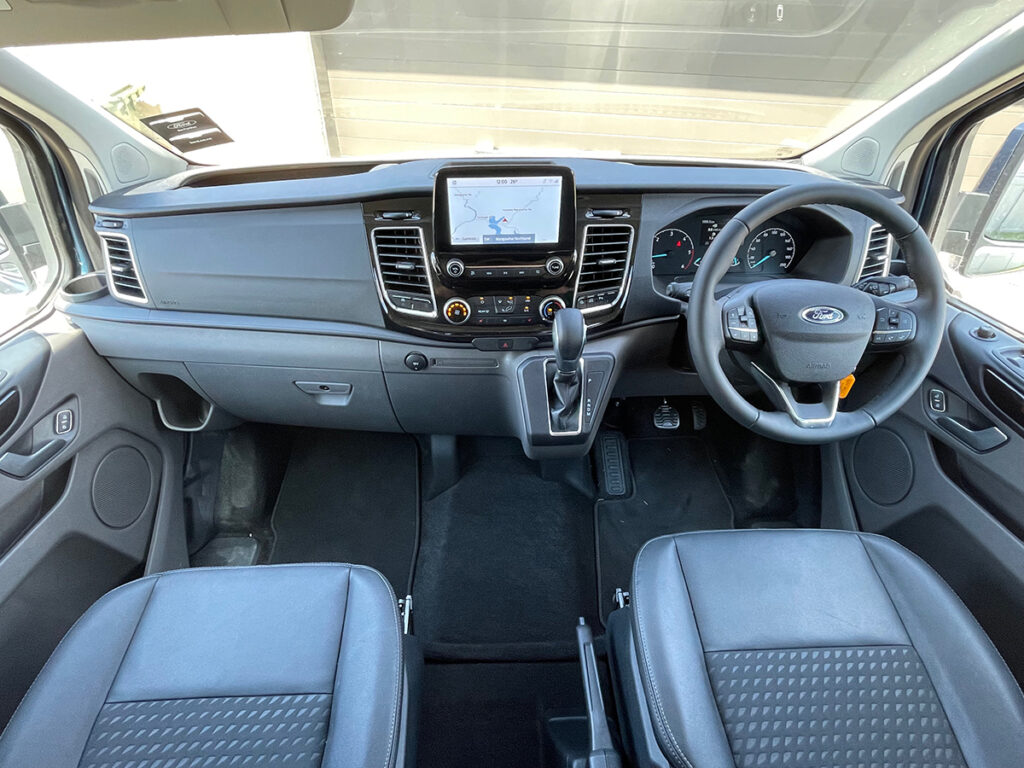
INSIDE
Standard equipment inside the DCiV Sport and the PHEV includes Ford’s SYNC3 full colour eight-inch touchscreen with Apple Car Play, Android Auto and satellite navigation.
A 4.2-inch full colour instrument cluster is also standard and joins MyKey, a programmable key that can be used to restrict vehicle settings like speed, driver assist technology, and the sound system.
Both variants have a heated windscreen and mirrors, seat heating for the driver and front passenger, manual air-conditioning, leather trimmed adjustable steering wheel, FordPass connect, four-speaker audio, and two USB ports.
The PHEV provides cloth upholstery and manual seat adjustment while the DCIV Sport offers a 10-way power adjustable driver’s seat and partial leather seat trim to complement the textured leather steering wheel.
Design details in the Sport include gloss black applique and detailing, and chrome vent surrounds.
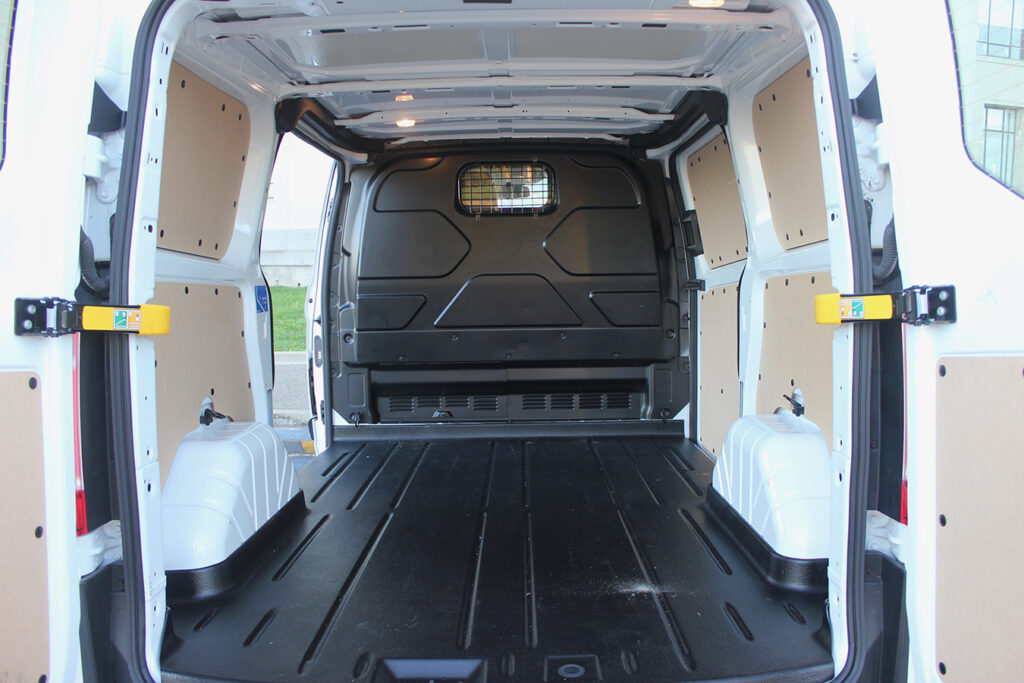
A standard reinforced rear bulkhead in the six-seat DCiV Sport is located behind the second row of seats, which provides 4.4-cubic metres of cargo space.
The bulkhead behind the single row of three seats in the PHEV, means there are six cubic metres of cargo space.
Both offer rear barn doors which open to 180 degrees allowing forklift access.
The DiCV Sport can swallow one standard Euro-sized pallet and the PHEV can manage two.
The rear load area has compartment lighting (halogen in the PHEV, LED in the DCIV Sport), sidewall trim board, tie-down points, and load floor protection.
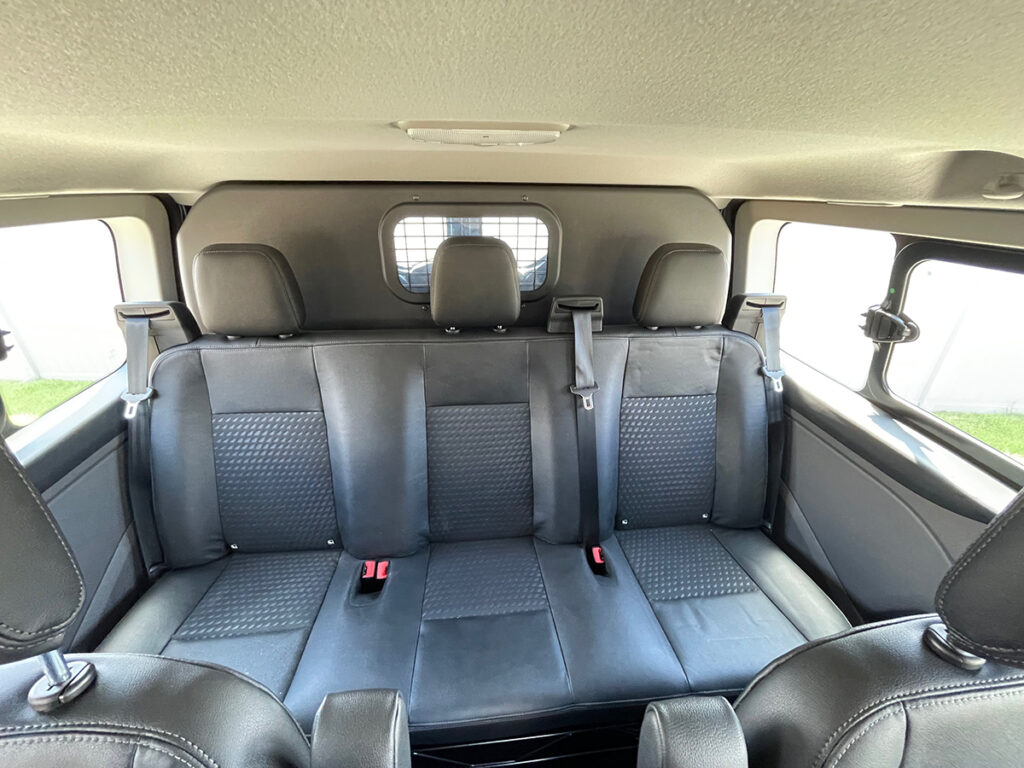
THE DRIVE
Both the DCIV Sport and the PHEV offer a commanding driving position and great visibility.
In spite of being different lengths, both have a decent turning circle and are easily manoeuvred into parking spaces thanks to the reversing camera and front and rear sensors.
But the driving experience is quite different from one to another.
The turbodiesel DiCV Sport feels quiet and refined around the city and on the open road but offers decent response and good fuel economy.
Rightcar.gov.nz quotes fuel consumption of 8.4 litres/100km, and the CO2 emissions are 219 grams/ km under the three phase worldwide harmonised light vehicles test procedure (3P-WLTP).
Under the Clean Car legislation buyers of a new Transit Custom DCiV Sport will have to pay a penalty fee from April 1, as the van exceeds the limit of 192g/ km. Indicative pricing would suggest a fee of $1552.50.
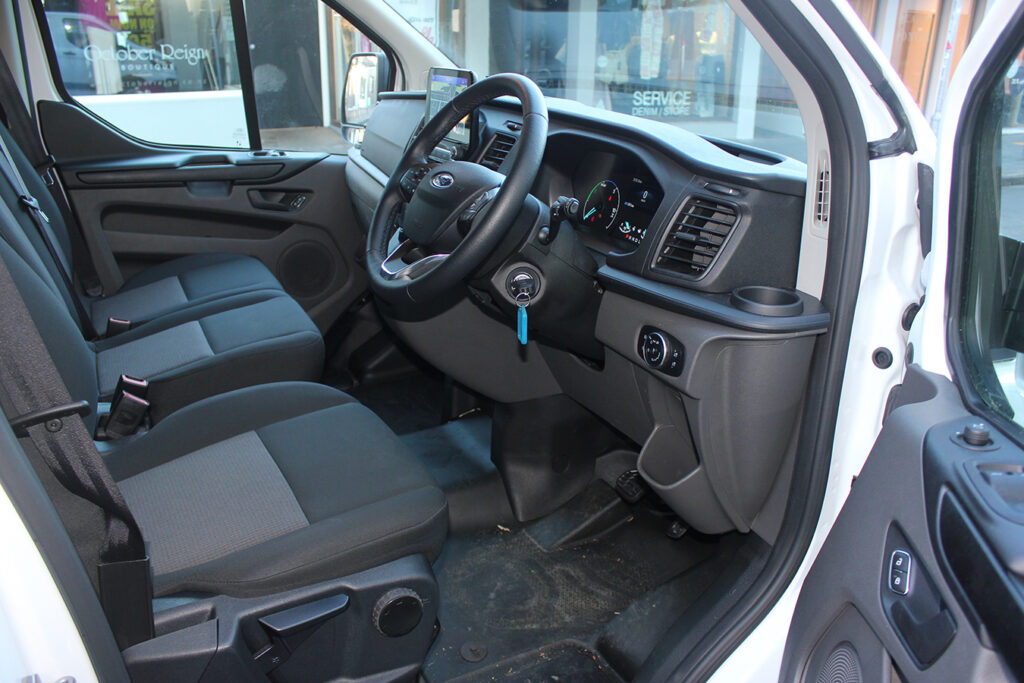
The PHEV is much quieter than the turobodiesel in urban operation, so much so that’s it hard to discern when the petrol engine kicks in to generate more power for the traction battery to deliver to the electric motor that drives the front-wheels.
Using B mode will elevate the strength of the PHEV’s regenerative brakes, allowing one pedal driving.
Ford quotes an electric range of 56km around town, and you can normally expect 40 to 45km in pure EV mode.
However, drivers can let the vehicle choose which mode it wants for peak efficiency or can force the petrol engine to recharge the battery for use later.
The combined range of stored mains power and range extended power is just over 500km, Ford says.
We noted that when running in hybrid mode when the battery was nearly flat the PHEV did appear to struggle a little with steep inclines on the open road.
Priced at $89,990 the Transit PHEV doesn’t qualify for the Government’s Clean Car rebate, but it does offer a solution for business operators needing a urban-focused low-emission tool-of-trade vehicle.

SAFETY
Building on its five-star ANCAP rating the Transit Custom’s driver assist technology includes autonomous emergency braking (AEB) with pedestrian detection, adaptive cruise control (ACC), traffic sign recognition (TSR), and lane keeping aid (LKA) with driver alert.
There are also blind spot information system (BLIS), rear cross traffic alert, and automatic headlights with auto high windscreen wipers.
There are six airbags (driver, front passenger, front side curtain, front side seat), and dynamic stability control (DSC) with roll-over mitigation and trailer sway control.
Other safety tech includes side-wind stabilisation, load adaptive control and hill launch assist, full colour rear-view camera, front and rear parking sensors, and SYNC emergency assist.
In January 2020, ANCAP recognised Ford’s progress in equipping its vehicles with advanced driving assistance systems, awarding a silver rating to the Transit Custom range for its collision avoidance performance.
OUR VIEW
These two Transit Custom variants sit in a very niche part of the light commercial market and there’s not a huge amount of competition.
Direct competitors to the DCiV Sport with two rows of seating and a bulkhead behind them are the Mercedes-Benz Vito Crew Cab (formerly known as the Valente) and the Volkswagen T6.1 Transporter Delivery Van plus.
Until the other brands offer a PHEV mid-size commercial van, the Transit Custom PHEV has the market to itself.
The fully electric LDV eDeliver3 ($55,000) is probably the closest vehicle dimensionally to the Ford and it offers the full $8625 Clean Car discount. But it offers up to 400km of driving range versus the Transit PHEV’s more than 500km.
